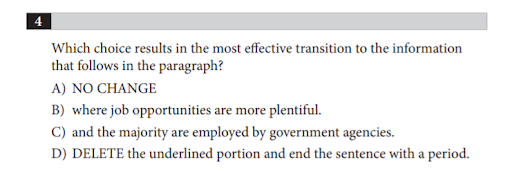Welcome back to the Upper Test Side, where Halloween must be getting close, since all these scary standardized tests keep popping up left and right. But really it’s the standardized tests that should be scared, because we’re exposing all their closely guarded secrets.
Our hot topic of the day is transitions, some of the most dangerous words on the street. You’re just minding your own business, thinking you’re heading in the right direction, and then bam! You forgot to look both ways.
Transitions are words or phrases that link two connected ideas. Whenever you encounter a transition in the wild, try to figure out whether the connected ideas are going in the same direction or in different directions. Here’s an example of a transition question from SAT Writing:


Different-direction transitions are pretty easy to spot (“however,” “nevertheless,” “despite,” etc.). When it comes to same-direction transitions, though, you may come across a few different categories. Some transitions show ordering (like “next,” “subsequently,” or “finally”). Some show causation (like “thus,” “therefore,” or “consequently”). Others just present additional information (“moreover,” “likewise,” or “furthermore”).
The sentence before the transition introduces the type of people with whom transportation planners work. The next sentence describes a situation in which representatives help to design trails/sidewalks. These ideas are going in the same direction. Unfortunately, there are no opposite-direction answer choices to cross off, but we can look at each option and figure out its specific meaning.
(A) “Next” shows an order of events. Not what’s going on here.
(B) “For instance” = an example. This could work, since the second sentence is giving an example of how people would work with transportation planners.
(C) “Furthermore” basically just means “additionally.” It’s a weaker choice than B.
(D) “Similarly” is used when comparing things. Again, not a match.
By breaking down each transition into its category, we can cross off the three wrong choices, leaving us with B, the correct answer.
Sometimes transition questions can be extended to whole clauses or sentences. Just like with single-word transitions, the key is that the transition needs to connect with what comes before as well as what comes after — just like the Upper Test Side’s very own Brooklyn Bridge, there has to be a solid connection in each direction. Here’s another SAT Writing example:


This question is asking us to specifically focus on the information that follows the transition phrase. When we read the rest of the paragraph, we see that it’s talking about a transportation planner figuring out traffic issues for a factory near a small town. Choice A mentions “rural areas,” which might be a match with “small town.” Choice B keeps the focus on “big cities,” which doesn’t match with the rest of the paragraph. Choice C mentions “government agencies,” which aren’t addressed in the paragraph. Choice D has the same issue as choice B in that the focus stays on big cities, which doesn’t connect to the information that follows about the small town and the factory.
Since B, C, and D all had issues, we’re left with just choice A. Even if you were on the fence about whether “small towns” count as “rural,” we know from the process of elimination that A is the only possible answer.
Transition Recap
Step 1: Find the Direction
Read the sentences. Do the ideas go in the same direction or in a different direction?
Step 2: Eliminate the Obviously Wrong Answers
If the ideas are same-direction, cross off different-direction transitions (and vice versa).
Step 3: Dig Deeper Into Any Remaining Choices
If you couldn’t cross off all wrong answers in Step 2, look closely at the remaining answers and notice subcategories like order, cause, and additional info.
Step 4: Build a Bridge
Before moving on to another question, make sure that the answer you’ve chosen connects to both the before and the after.
So who’s afraid of a big, bad transition? Not us. We built a bridge and got over it.
Until next time.
X, O, X, and O,
Grammar Girl
P.S. Need extra help with transitions or any other subjects? Check out our experts and schedule a consultation today.

